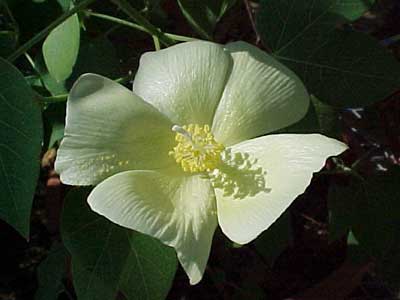Issue 4 Table of Contents

|
FEATURED ARTICLEBreeding and Genetics Upland Cotton (<em>Gossypium hirsutum</em> L.) x Hawaiian Cotton (<em>G. tomentosum</em> Nutt. Ex. Seem.) F<sub>1</sub> Hybrid Hypoaneuploid Chromosome Substitution Series Sukumar Saha, Dwaine A. Raska, and David M. Stelly
Pages: 263-272
Abstract
| Full Text PDF (198K)
Open flower of a monosomic substitution interspecific F1 hybrid plant that is hemizygous for the chromosome of G. tomentosum. As with most of the substitution interspecific F1 hybrids, the flowers were intermediate G. hirsutum and G. tomentosum in size, pubescence, petal color and pollen color. These hypoaneuploid chromosome substitution stocks provide a stepping stone toward high-resolution chromosome-specific genetic dissection of complex traits, germplasm introgression, and cotton improvement.
|
|---|
Issue Editors
|
Agronomy and Soils
Response of Yield, Yield Components, and Fiber Properties of Egyptian Cotton (<em>Gossypium barbadense</em> L.) to Nitrogen Fertilization and Foliar-applied Potassium and Mepiquat Chloride Zakaria M. Sawan, Mahmoud H. Mahmoud, and Amal H. El-Guibali
Pages: 224-234 Abstract
| Full Text PDF (123K)
Agronomy and Soils
Comparison of Growth and Yield Components of Conventional and Ultra-narrow Row Cotton Earl D. Vories, and Robert E. Glover
Pages: 235-243 Abstract
| Full Text PDF (106K)
Agronomy and Soils
Effects of a Short-term Corn Rotation on Cotton Dry Matter Partitioning, Lint Yield, and Fiber Quality Production W.T. Pettigrew, W.R. Meredith Jr., H.A. Bruns, and S. R. Stetina
Pages: 244-251 Abstract
| Full Text PDF (110K)
Arthropod Management
Effect of Genotype, Edaphic, Environmental Conditions, and Agronomic Practices on Cry1Ac Protein Expression in Transgenic Cotton Ian J. Rochester
Pages: 252-262 Abstract
| Full Text PDF (178K)
Engineering and Ginning
Cleaning Performance of Modified Cylinder Cleaners Sanh Le
Pages: 273-283 Abstract
| Full Text PDF (200K)
Engineering and Ginning
Gross Monetary Returns for Conventionally Processed Cotton J. Clif Boykin
Pages: 284-299 Abstract
| Full Text PDF (153K)
|
Engineering and Ginning
Historical Review on the Effect of Moisture Content and the Addition of Moisture Addition to Seed Cotton before Ginning on Fiber Length Richard K. Byler
Pages: 300-310 Abstract
| Full Text PDF (109K)
Engineering and Ginning
Harvesting and Ginning a Cotton with a Fragile Seed Coat Carlos B. Armijo, Greg A. Holt, Kevin D. Baker, Sidney E. Hughs, Edward M. Barnes, and Marvis N. Gillum
Pages: 311-318 Abstract
| Full Text PDF (225K)
Weed Science
Glufosinate Antagonizes Postemergence Graminicides Applied to Annual Grasses and Johnsongrass Andrew P. Gardner, Alan C. York, David L. Jordan, and David W. Monks
Pages: 319-327 Abstract
| Full Text PDF (103K)
Weed Science
Management of Annual Grasses and <em>Amaranthus</em> spp. in Glufosinate-resistant Cotton Andrew P. Gardner, Alan C. York, David L. Jordan, and David W. Monks
Pages: 328-338 Abstract
| Full Text PDF (122K)
Editorial Notes
Annual Report of the <em>Journal of Cotton Science</em> Patrick D. Colyer
Pages: 339-340 Abstract
| Full Text PDF (53K)
|
